This page answers the most common questions about Virginia's biennial budget, providing a basic understanding of the budget and related processes, including where the money comes from and where it goes. The specific data used on this page represents the 2020 - 2022 biennial budget as reflected in the 2020 Appropriation Act. (Chapter 56, 2020 Special Session I, Acts of Assembly)
Jump down to answers for the following questionsWhere does the money come from?
State government resources can be grouped into several categories: taxes, grants, fees, sales, earnings, transfers, and balances. For the 2020-2022 biennium, total state resources available for appropriation are projected to equal $141.3 billion, including year-end balances, transfers, and bond proceeds.
Total revenues from all tax sources are projected to be $54.7 billion. Tax revenues include $31.5 billion from individual income taxes and $5.9 billion from motor vehicle and highway taxes. Other large revenue sources for the biennium include $31.3 billion in federal grants and 18.6 billion in institutional revenue, primarily fees collected at colleges and universities, medical and mental hospitals, and correctional facilities.
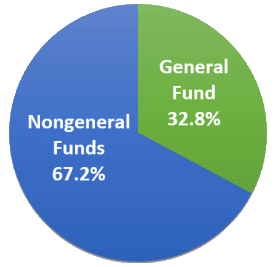
For budgeting purposes, state revenues are divided into two broad types: (1) the general fund and (2) nongeneral funds.
More than half of state revenues (67.2 percent) are "nongeneral funds," or receipts set aside for specific purposes. For example, motor vehicle and gasoline taxes are earmarked by law for transportation programs, student tuition and fees must support higher education, and federal grants are designated for specific activities.
General fund revenues make up 32.8 percent of the budget. They are mostly derived from direct general taxes paid by citizens and businesses in Virginia. Because general fund revenue can be used for a variety of government programs, these are the funds that the Governor and the General Assembly have the most discretion to spend.
General fund revenues
General fund revenues for the 2020-2022 biennium total $43.5 billion, not including balances and transfers. The general fund is derived primarily from three major revenue sources:

- Individual income taxes ($31.5 billion): Taxes paid by individual citizens on their income;
- Corporate income taxes ($2.2 billion): Taxes paid by businesses and corporations on their income; and
- Sales and use taxes ($6.8 billion): Taxes paid by citizens and business on goods they buy.
Other revenue sources for the general fund include $696.9 million from insurance premium taxes (taxes paid by insurance companies on premiums), $815.4 million from wills, suits, deeds and contract fees (primarily from the recordation tax on mortgages), and $1.5 billion in other miscellaneous taxes.
Finally, the Commonwealth expects to transfer $1.2 billion to the General Fund for ABC profits and other miscellaneous transfers.
Table showing 2020-2022 revenue estimates
Nongeneral fund revenues
Although most public attention is focused on general fund revenue, the majority of revenue in the state budget is "nongeneral funds." These funds are earmarked by law for specific purposes. For the biennium, nongeneral fund revenues total $79.0 billion, not including: balances, lottery proceeds ($1.3 billion), internal service funds, and bond proceeds.
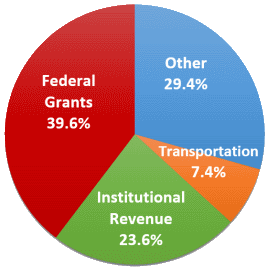
Federal grants are the largest source of nongeneral fund revenue ($31.3 billion for the biennium). Frequently these grants do not come to the state as simple cash transfers. The federal government mandates many program requirements as conditions of the grants and often states must provide matching funds. Entitlement programs such as Medicaid and Aid to Families with Dependent Children are examples of programs that require a state contribution.
The second largest source of nongeneral fund revenue is institutional revenue ($18.6 billion for the biennium). The principle sources of this revenue are patient fees at teaching hospitals and mental health institutions as well as tuition and fees paid by students at institutions of higher education.
State transportation revenue comes from several sources including the motor vehicle fuels tax, the motor vehicle sales and use tax, road taxes, vehicle license fees, state sales tax, interest earnings, and other miscellaneous taxes and fees. Money in this fund is used to support highway construction and maintenance and operating costs. Federal, local, and toll revenues are also used to finance transportation programs. For the biennium, transportation revenues are anticipated to be $5.9 billion.
Other nongeneral fund revenue sources include fees paid by citizens and businesses for licenses ($2,840.1 million), profits on sales of alcoholic beverages ($2,365.3 million), Unemployment Insurance Fund ($776.0), and earnings on state funds and rents ($451.2 million).
Table showing 2020-2022 revenue estimates
Where does the money go?
Virginia's state government budget is divided into an operating budget and a capital budget. The operating budget includes expenses to run the daily activities of government. The capital budget includes the one-time costs of building, improving, or repairing government facilities. The budget of the Commonwealth for the 2020-2022 biennium includes $134.2 billion for operating expenses and $3.3 billion in capital outlay.
Looking at total operating funds from all sources, the majority of the money goes to education (32.5 percent), health and human resources (33.5 percent), and transportation (14.3 percent):
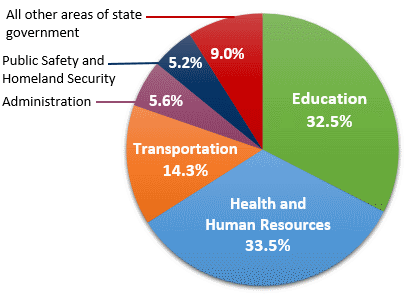
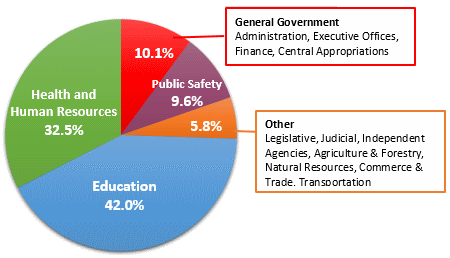
Considering only nongeneral funds, funds that are earmarked by law for specific purposes, the majority goes to education (27.6 percent), health and human resources (34.0 percent), and transportation (21.8 percent):
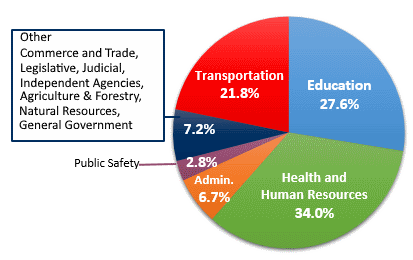
How is Virginia's budget adopted?
Virginia has a biennial budget system, which means it adopts a two-year budget. The biennial budget is enacted into law in even-numbered years, and amendments to it are enacted in odd-numbered years. (For example, the budget for the current biennium was adopted by the 2020 General Assembly and will be amended by the 2021 General Assembly.)
Developing the Commonwealth's budget is a process which takes many months and involves many participants, from the public to state agencies to the legislature. The process includes five distinct phases:
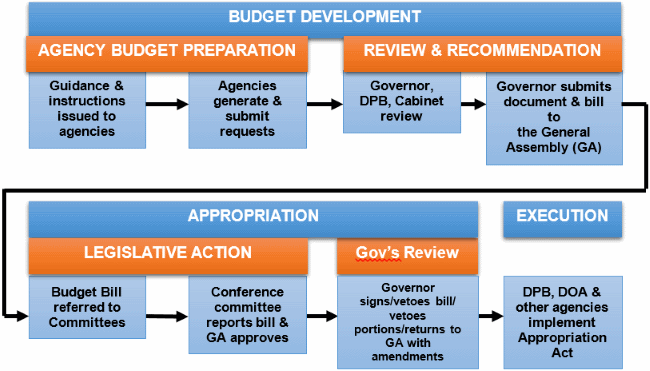
(1) Agency budget preparation phase. State agencies analyze their programs and needs through a strategic planning process which includes a review of their mission and how well they serve their customers through customer satisfaction surveys or other methods of public input. Based on this analysis, agencies prepare and submit their requests for funding to the Department of Planning and Budget (DPB). Agencies generally present their proposals to DPB in the early fall.
(2) Budget development phase. DPB analyzes the budget requests of agencies to verify costs, confirm the need for services, investigate any alternatives for funding, and identify policy issues for the Governor's consideration. This analysis takes place during the fall.
In the late fall, the Governor and his Cabinet Secretaries work together to prepare a proposed budget which reflects the Administration's priorities.
The Governor submits his budget proposals to the General Assembly on or before December 20 in the form of a bill. The Budget Bill is a legal document listing budget appropriations at a detailed line-item level. He also distributes a "Budget Document" which sets forth his proposals in a more readable form. The Budget Document is an Executive Branch document and can be found on our Virginia's Budget page.
The "Budget Bill" is a legislative document and can be found on the Legislature's LIS System. The direct link to the 2020-2022 Budget Bill is https://budget.lis.virginia.gov/bill/2020/2/HB5005/Chapter/
(3) Legislative action phase. The General Assembly convenes each year on the second Wednesday of January. The Governor's proposed budget is submitted to the General Assembly in the form of a "bill." In each house, the budget bill is referred to committees which hold public hearings and committee discussions. In the House of Delegates, the House Appropriations Committee reviews the budget bill. In the Senate, the budget bill is referred to the Senate Finance Committee. The committees may introduce amendments to the budget bill.
After review by each of these committees, the amended budget bill is brought to the floor of each house, where other amendments may be made. Each house votes on the amended budget bill. After each house votes on its own version of the budget bill, the bill "crosses over" to the other house where it is again debated and voted on. Before the General Assembly adjourns for the session, a conference committee resolves any differences between the versions passed by the two houses.
The General Assembly then sends the budget bill to the Governor for his signature.
(4) Governor's review phase. The Governor reviews the bill passed by the General Assembly. He may sign it, veto the entire bill or certain line items, or recommend amendments. If the Governor vetoes the bill or any items of the bill, it goes back to the General Assembly during a reconvened session in the spring. If he recommends amendments, the bill is returned to the reconvened session for consideration and action by the General Assembly on the Governor's proposed amendments.
(5) Budget execution phase. The budget passed by the General Assembly and enacted into law goes into effect on July 1 in even-numbered years and on the date of passage in odd-numbered years.
How much of the state's money goes back to localities?
About a third of the state's operating budget (all funds) either goes directly to localities for locally operated programs or is spent by the state on behalf of localities for specific programs. The majority of the money that the state sends to localities goes to operate public schools. The state also directly shares with local governments the revenues from certain sources, such as recordation taxes and profits earned from the sale of wine and alcoholic beverages. In addition, the state shares a portion of its revenue with localities that have police departments.
The state gives localities money to construct and maintain secondary roads, and to pay the salaries of local elected officials, such as treasurers, commissioners of the revenue, commonwealth's attorneys, and clerks of the courts and their office staff. Local sheriffs' offices and jails receive the largest share of the state's support for these Constitutional officers. The state funds local welfare offices, local health departments, and community-operated mental health and juvenile corrections programs.
The state also funds a wide range of other local activities and services. These include but are not limited to local libraries, improvements to local airports, parks and recreation programs, local emergency services teams, and solid waste and wastewater treatment plants.
The Department of Planning and Budget defines "state aid to localities" as:
- any payment made directly to a local government or school division,
- any payment made on behalf of a local government or school division
- any payment made to an organization or group that provides a direct benefit to a local government or its residents, such as a public library, planning district commission, or a mental health community service board.
Based on this definition, state aid programs and activities are classified so they can be monitored through the state's financial systems and reported to the General Assembly and taxpayers.
Page Updated 2/2/2021




